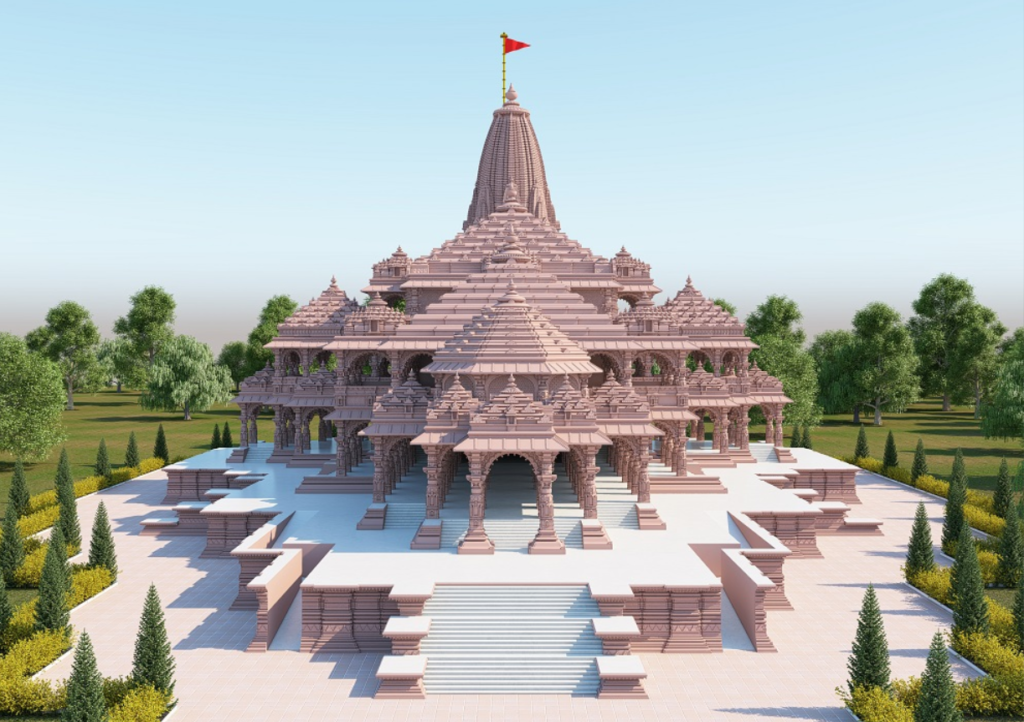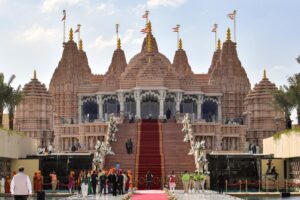I. Ayodhya Ram Mandir Consecration in Uttar Pradesh (अयोध्या राम मंदिर प्राण-प्रतिष्ठा)
Ayodhya Ram Mandir Uttar Pradesh: In Hinduism, the day of 22 January 2024 will be recorded in golden letters, because on this day, after years, Ram Lalla will reside in his grand Ram temple in Ayodhya. Preparations for the consecration of Shri Ram are in the final stages. The whole world will witness this historic moment.
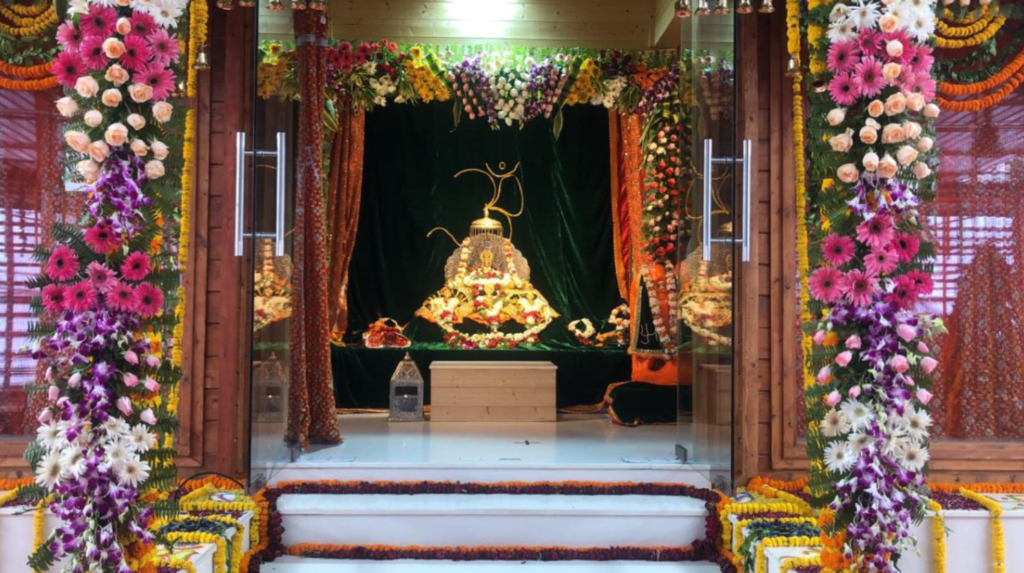
The outline for the consecration of Ram temple in Ayodhya has been decided. Many rituals will take place from January 15 to January 22. Know the complete schedule of the Ram temple program, the auspicious time of Pran Pratishtha.
A. Schedule in Ram Mandir from 15-22 January 2024
- 15 January 2024 – On this day Kharmas are ending on Makar Sankranti. The idol of Ramlala i.e. the idol of the child form of Shri Ram will be installed in the sanctum sanctorum.
- 16 January 2024 – From this day, the rituals for the residence of the idol of Ramlala will also begin.
- 17 January 2024 – From this day the statue of Ram Lala will be taken out for a city tour.
- 18 January 2024 – The process of consecration of life will begin from this day. There will be mandap entry puja, Vaastu puja, Varun puja, Vighnaharta Ganesh puja and Martika puja.
- 19 January 2024 – The Yagya fire pit will be established in the Ram temple. The fire will be lit by a special method.
- 20 January 2024 – The sanctum sanctorum of Ram temple will be sanctified with 81 Kalash, in which water from different rivers has been collected. There will be a Vaastu peace ritual.
- 21 January 2024 – On this day, amidst special worship and havan in the Yagya ritual, Ram Lala will take a divine bath with 125 urns.
- 22 January 2024 – The consecration is to take place on 22 January 2024. On this day, there will be a great puja of Ramlala in Mrigashira Nakshatra in the middle period.
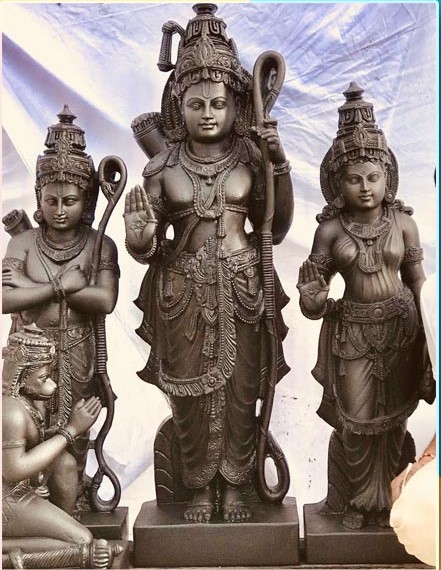
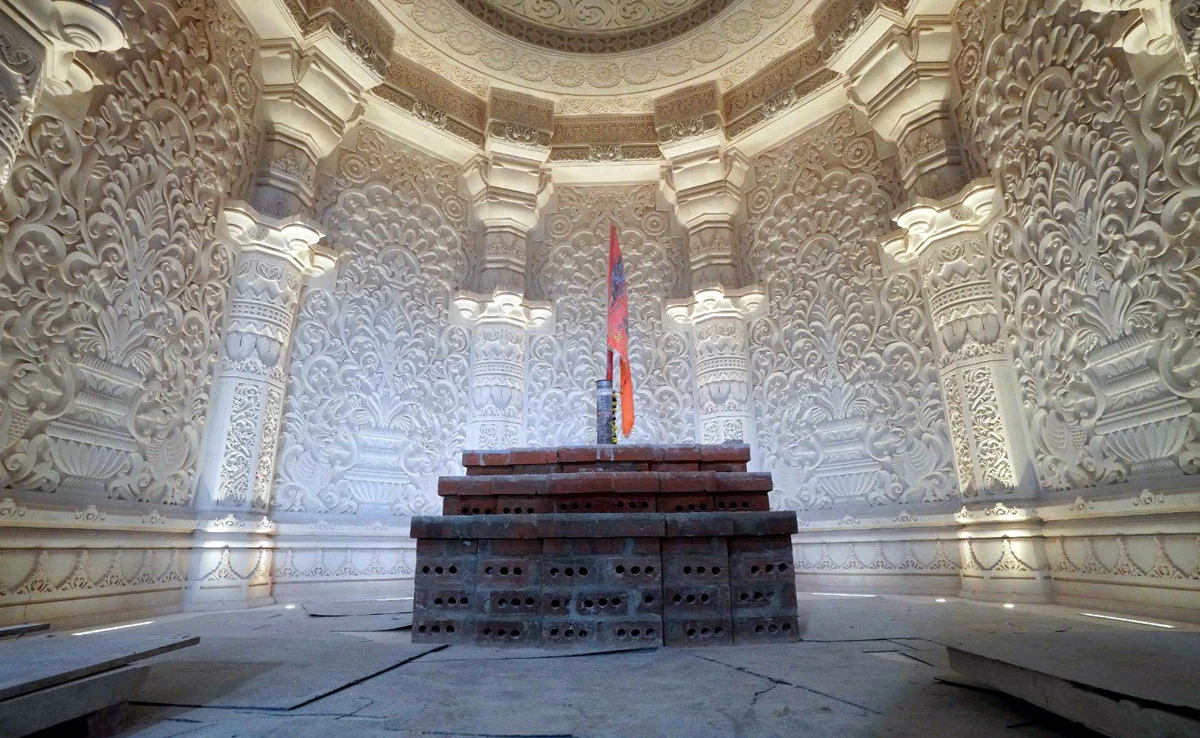
B. Ram Mandir Pran Pratishtha 2024 Muhurat
The wait of nearly five centuries for the Ram temple in Ayodhya is about to end. The time for installation of the idol of Ram Lala in Ram temple will be from 12:29 am to 12:30 am on 22 January 2024. There will be only 84 seconds of auspicious time for Pran Pratistha.
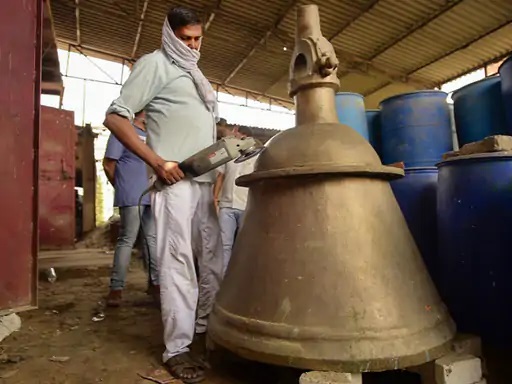

II. The Ayodhya Ram Mandir History
The Ram Mandir in Ayodhya, India, has a long and contentious history that dates back several centuries. The controversy surrounding the site is primarily rooted in religious and historical claims. The brief overview:
A. Ayodhya Ram Mandir Uttar Pradesh Ancient History:
Ayodhya is considered to be the birthplace of Lord Rama, a central figure in the Hindu epic Ramayana. According to Hindu belief, Rama is an incarnation of Lord Vishnu. The site is believed to be the location of the ancient temple, the exact construction date of which is unclear.
B. Babri Masjid Construction:
In the 16th century, the Mughal emperor Babur ordered the construction of a mosque at the site in Ayodhya. The Babri Masjid was completed in 1528.
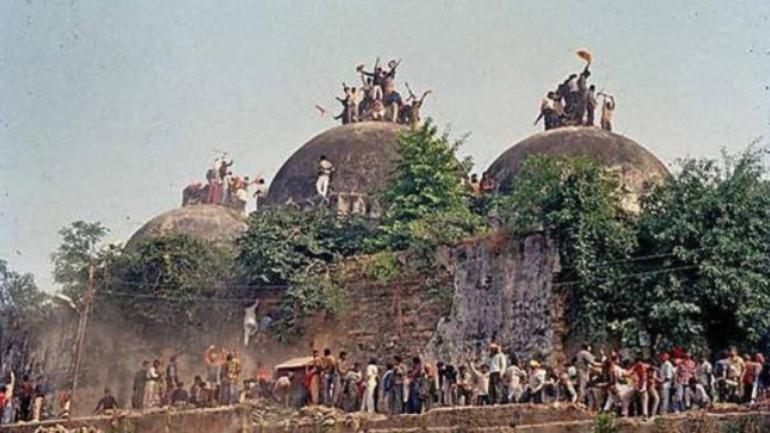
C. Ayodhya Ram Mandir Uttar Pradesh Controversy Begins:
In the 19th century, disputes arose between Hindu and Muslim communities regarding the ownership of the site. The Babri Masjid became a focal point of tension, with both communities claiming the land.
D. Ram Janmabhoomi Movement:
The modern controversy gained momentum in the 1980s when the Vishva Hindu Parishad (VHP) launched the Ram Janmabhoomi movement, demanding the construction of a temple at the site believed to be the birthplace of Lord Rama.
E. Babri Masjid Demolition:
On December 6, 1992, a large mob of Hindu activists demolished the Babri Masjid, leading to widespread communal riots and tensions across India.
F. Ayodhya Ram Mandir Uttar Pradesh Legal Battles:
After the demolition, the legal battle over the ownership of the site intensified. Various petitions were filed in the courts representing both Hindu and Muslim interests.
G. Ayodhya Ram Mandir Verdict:
On November 9, 2019, the Supreme Court of India delivered a historic verdict, stating that the entire disputed land in Ayodhya should be handed over to a trust for the construction of a Ram temple. The court also directed the government to provide an alternate five-acre plot to the Sunni Waqf Board for the construction of a mosque.
H. Ayodhya Ram Mandir Uttar Pradesh Construction:
In 1988, the Sompura family from Ahmedabad conceptualized the original design for the Ram Mandir. Renowned for their temple designs spanning 15 generations, including the iconic Somnath temple, the Sompuras, led by chief architect Chandrakant Sompura, along with his sons Nikhil and Ashish, contributed significantly to the temple’s vision.
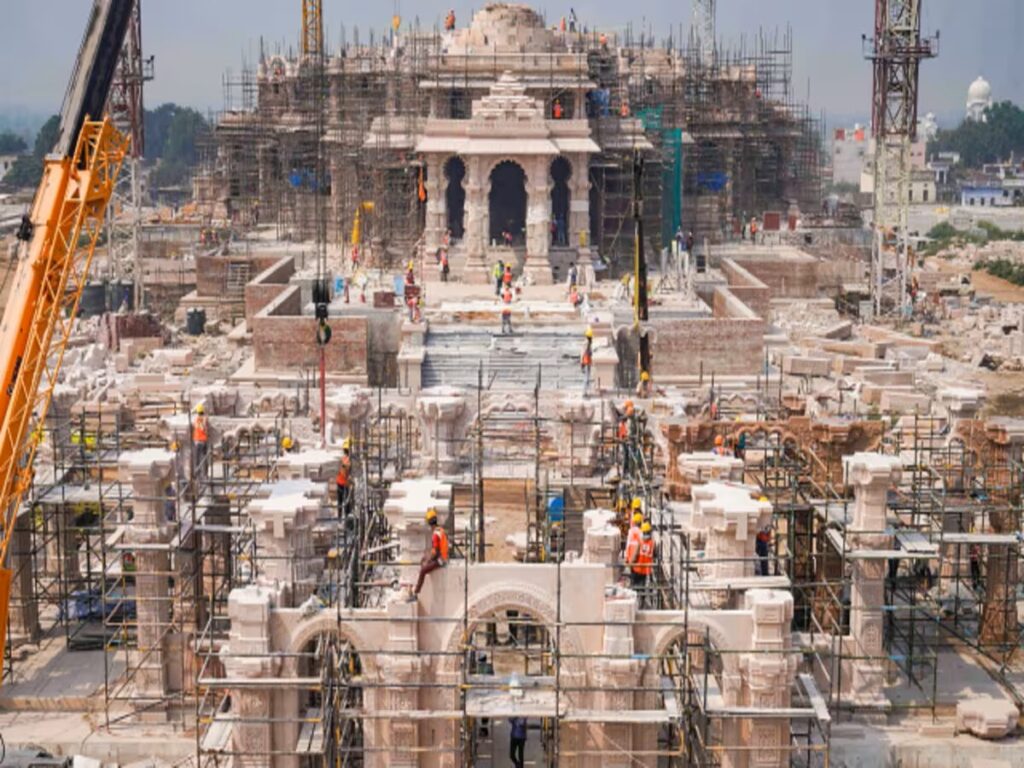
After 2020 Construction
In 2020, a revised design, rooted in Hindu texts, Vastu shastra, and Shilpa shastras, was presented by the Sompuras. The temple, set to be 235 feet wide, 360 feet long, and 161 feet high, will rank as the world’s third-largest Hindu temple. The Gurjara-Chaulukya style of Nagara architecture, prevalent in northern India, inspires its aesthetic. The temple model was unveiled at the Prayag Kumbh Mela in 2019.
The main structure, elevated on a platform, will comprise three stories, featuring five mandapas in the garbhagriha and entrance passage. Adhering to the Nagara style, these mandapas will boast shikhara embellishments. With 366 columns, each adorned with 16 idols, including Shiva’s incarnations, Dashavataras, Chausath Yoginis, and Saraswati’s forms, the temple’s sanctum sanctorum will be octagonal, following Vishnu temple design scriptures.
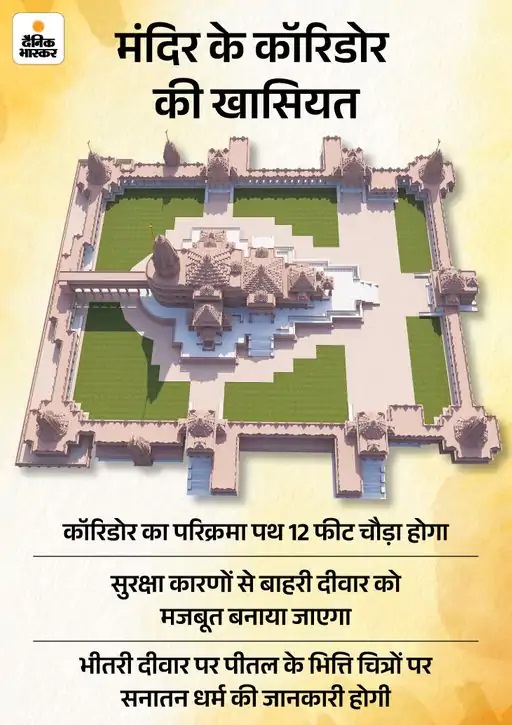
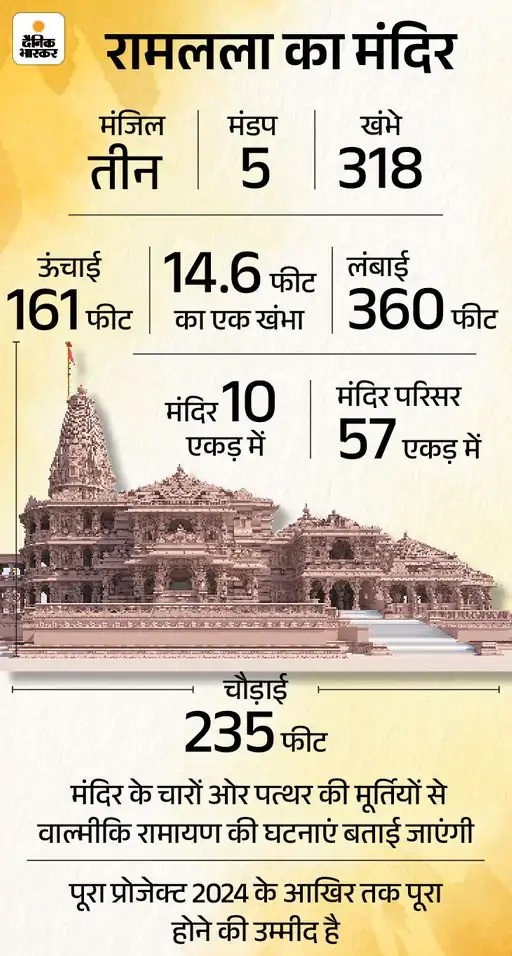
Spanning 10 acres, the temple complex will encompass a prayer hall, lecture hall, educational facility, museum, and cafeteria on 57 additional acres. The committee envisions hosting over 70,000 visitors. Larsen & Toubro, offering their services for free, oversees the project. Collaborating entities like the Central Building Research Institute, National Geophysical Research Institute, and IITs from Bombay, Guwahati, and Madras contribute expertise in soil testing, concrete, and design.
Constructed with 600,000 cu ft of sandstone from Baansi, Rajasthan, the temple boasts a culturally significant touch as Thailand contributes soil to the Ram Janmabhoomi, extending their earlier gesture of sending water from Thai rivers in honor of the temple’s inauguration. Notably, the temple’s construction excludes iron, using ten thousand copper plates to fuse stone blocks together.
III. The Ram Janmabhoomi Coutcase Timeline
The Ram Janmabhoomi-Babri Masjid land dispute was a long-standing legal and socio-political issue in India. The dispute revolved around a religious site in Ayodhya ram mandir Uttar Pradesh, where Hindus believe Lord Ram was born. The Babri Masjid, a mosque, was constructed in the 16th century by the Mughal emperor Babur at the same location.
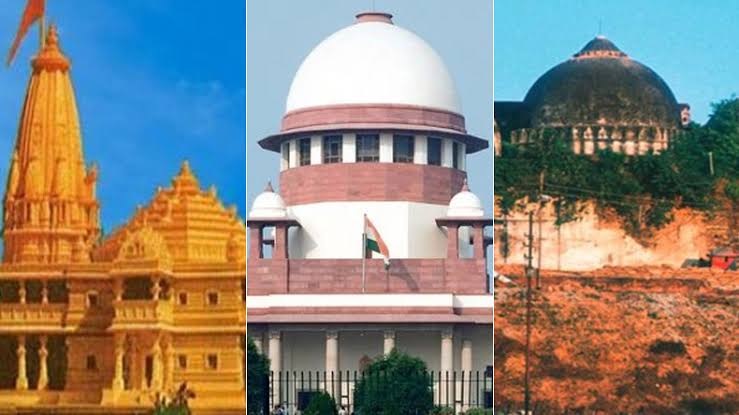
The timeline of key events related to the Ram Janmabhoomi court case:
- 1528: Babri Masjid built by Mughal Emperor Babur.
- 1853-1859: The first recorded instances of religious violence at the site. Legal disputes over the site begin.
- 1949: Idols of Lord Ram are surreptitiously placed inside the mosque, leading to the locking of the mosque.
- 1950: Gopal Singh Visharad files a suit seeking permission to worship the idols.
- 1959: Nirmohi Akhara files a suit claiming possession and management rights over the disputed site.
- 1986: A district judge orders the opening of the locks, allowing Hindus to worship inside the mosque. This event escalates the tension.
- 1989: The Vishwa Hindu Parishad (VHP) launches a movement for the construction of a Ram temple at the disputed site.
- 1990: VHP volunteers partially damage the mosque.
- 1992: On December 6, a large mob of Hindu activists demolishes the Babri Masjid, leading to widespread communal riots.
- 1993: The central government acquires the land around the disputed site.
- 2002: The Allahabad High Court begins hearing the case.
- 2010: The Allahabad High Court delivers its verdict, dividing the disputed land into three parts: one-third for the Sunni Waqf Board, one-third for the Nirmohi Akhara, and one-third to the party for ‘Ram Lalla’ (the infant Lord Ram).
- 2011: Various parties appeal against the Allahabad High Court verdict in the Supreme Court.
- 2019: The Supreme Court begins daily hearings of the case.
- 2019: On November 9, the Supreme Court delivers a unanimous verdict, awarding the entire disputed land to the Hindus for the construction of a Ram temple. The court also directed the government to allocate an alternative 5-acre plot to the Sunni Waqf Board for the construction of a mosque.
IV. Architecture of Ayodhya Ram Mandir Uttar Pradesh
The Ram Mandir in Ayodhya stands as a magnificent architectural marvel, seamlessly blending historical legacy with meticulous design evolution. Its inception in 1988, spearheaded by the visionary Sompura family, and renowned architects, set the foundation for a structure deeply rooted in Hindu texts. Envisioned as the world’s third-largest Hindu shrine, the temple boasts impressive dimensions – 235 feet wide, 360 feet long, and soaring to a height of 161 feet.
A. Origin and Design Genesis
The Sompura family, with a rich legacy spanning 15 generations, originally conceptualized the temple’s design in 1988. Led by chief architect Chandrakant Sompura and supported by his sons Nikhil and Ashish, the family has left an indelible mark with contributions to over 100 temples globally, including the iconic Somnath temple.
B. Design Evolution in 2020
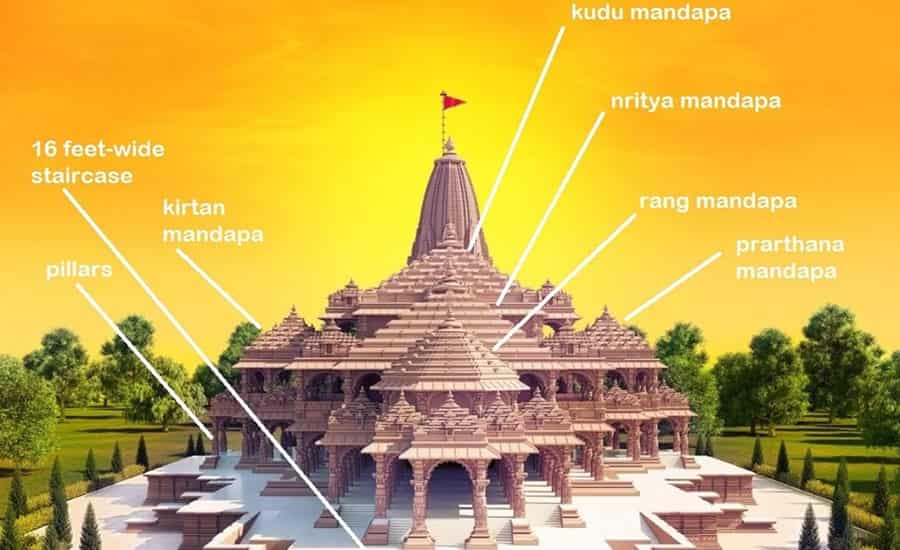
In 2020, the design underwent a meticulous evolution, aligning itself with Hindu texts like Vastu Shastra and the Shilpa Shastras. The revised blueprint, unveiled during the Prayag Kumbh Mela in 2019, retained the traditional essence while introducing alterations for a more holistic approach.
C. Grandeur in Structural Dimensions
With dimensions making it the third-largest Hindu shrine globally, the temple’s grandiosity follows the Gujara-Chaulukya style of Northern Indian temple architecture. Elevated on a raised platform, the main structure comprises three stories, featuring five mandapas in the garbhagriha and at the entryway, all adorned with shikhara in adherence to the Nagara style.
D. Features of Architectural Brilliance
A distinctive feature includes 366 columns, each embellished with 16 idols representing various deities, adding a spiritual dimension to the architectural masterpiece. The temple complex, sprawling across 10 acres and encompassing prayer halls, lecture halls, educational facilities, a museum, and a cafeteria, anticipates accommodating over 70,000 visitors.
E. Nagara Style of Temple Architecture
Exploring the Nagara style prevalent in northern India, the architecture features an upraised platform (jagati), mandapas adorned with shikhara, and a distinctive spire. The absence of elaborate boundary walls and gateways distinguishes it from south Indian temples, solidifying its unique identity in India’s rich cultural heritage.
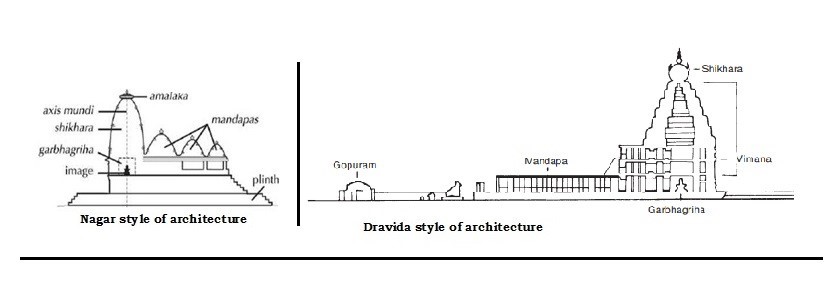
The magnificent temple at Rama Janmabhoomi in Ayodhya will be crafted in the Nagara style of temple architecture, a tradition prominent in northern India.
- In the Nagara architectural style, temples are typically built on an elevated platform known as jagati. Mandapas grace the front of the Garbhagriha, adorned with the distinctive Shikhara, the tallest of which stands proudly above the Garbhagriha.
- Unlike other styles, the Nagara architecture tends to forgo elaborate boundary walls or grand gateways. Notably, water tanks are not a common feature within the temple premises, and the pradakshina patha, or circumambulatory path, is often sheltered.
- A defining characteristic of the Nagara style is the placement of the garbhagriha directly beneath the towering spire, emphasizing a vertical and majestic aesthetic.
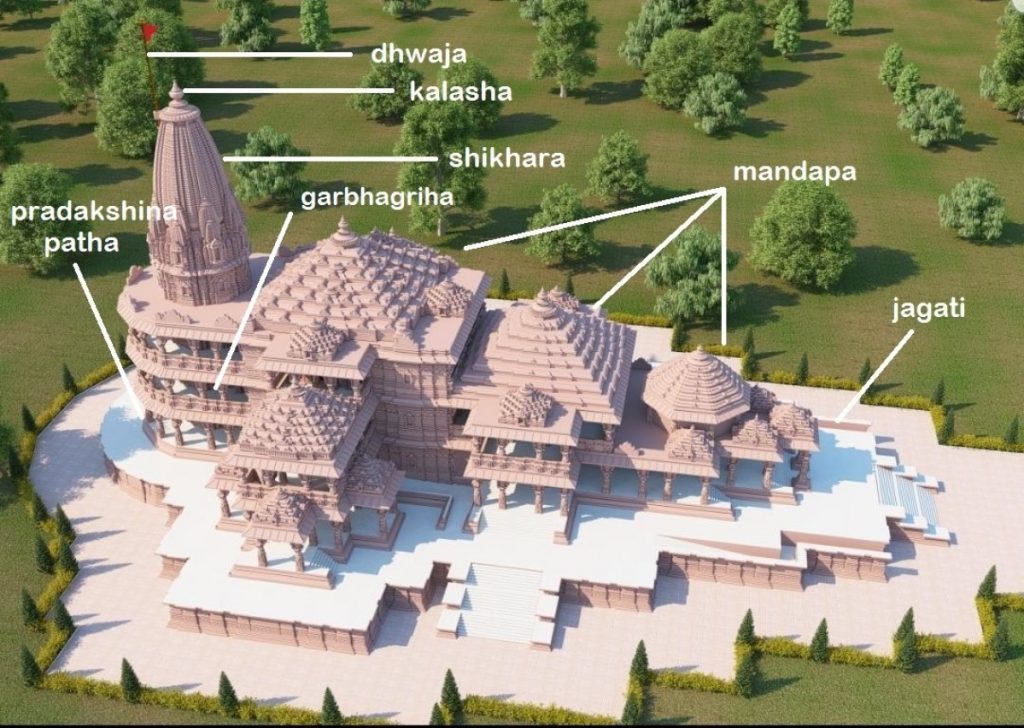
The fundamental structure of a Hindu temple comprises key architectural components:
- Garbhagriha: This is a small chamber where the principal deity or deities of the temple are enshrined.
- Mandapa: Positioned at the entrance, this portico or hall is designed to accommodate a large number of devotees.
- Shikhara: A towering spire, likened to a mountain, takes various shapes ranging from pyramidal to curvilinear.
- Vahana: The mount or vehicle of the main deity is strategically placed, often in the line of sight from the Garbhagriha.
Subdivisions: Within the Nagara school, there are further subdivisions based on regions such as Odisha, Khajuraho, and Solanki, each contributing unique nuances to the architectural heritage of Hindu temples.
F. Shikhara Varieties and Comparisons
The shikhara of the temple showcases the phamsana style, featuring a square base and a straight-line outline. Upon observing, one can draw parallels with the Vishwanath temple in Khajuraho, noting resemblances in the Latina-style shikhara. This style is marked by a gracefully curved pyramidal structure, ultimately crowned with an Amalaka and a Kalasha, echoing the architectural aesthetics seen in Khajuraho’s temple.
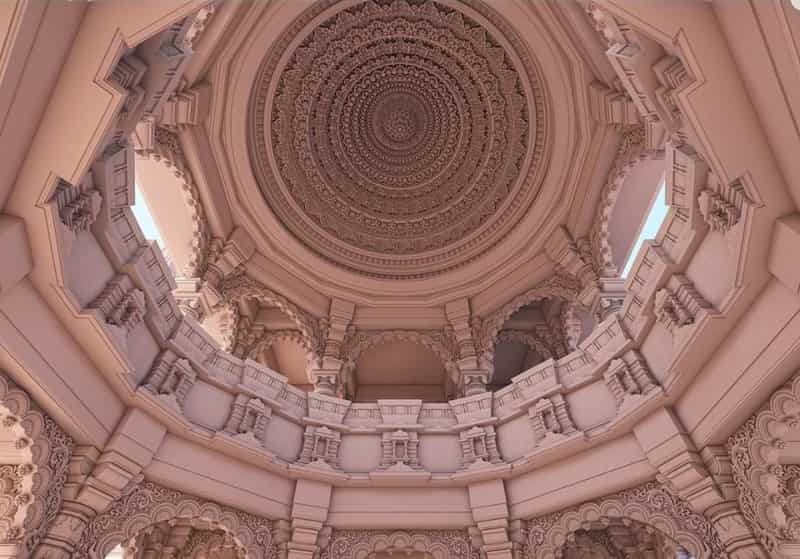
V. How to Reach Ayodhya Ram Mandir Uttar Pradesh
- By Air: The nearest airport to Ayodhya is Lucknow International Airport. Travelers can also access Ayodhya from Gorakhpur, Prayagraj, and Varanasi Airports.
- By Train: Faizabad and Ayodhya serve as major railway stations in the district and have excellent connectivity to almost all major cities and towns. By rail, Ayodhya is 128 km from Lucknow, 171 km from Gorakhpur, 157 km from Allahabad, and 196 km from Varanasi. It is also 135 km from Lucknow, 164 km from Gorakhpur, 164 km from Prayagraj, and 189 km from Varanasi.
- By Road: Uttar Pradesh Transport Corporation buses operate 24 hours a day, providing easy access to Ayodhya from all directions. The city is approximately 130 km from Lucknow, 200 km from Varanasi, 160 km from Prayagraj, 140 km from Gorakhpur, and about 636 km from Delhi. Regular bus services are available from Lucknow, Delhi, and Gorakhpur, as well as from Varanasi, Prayagraj, and other locations according to their schedules.
VI. Which company has built the Ram temple?
L&T took over the construction and TCE took over the management. Tata Group has contributed fully to the construction of Ram Janmabhoomi Teerth Kshetra Temple in Ayodhya. Tata Consulting Engineers company has worked as management consultants in the construction of this temple.

